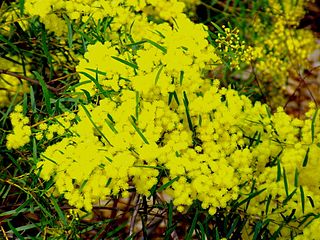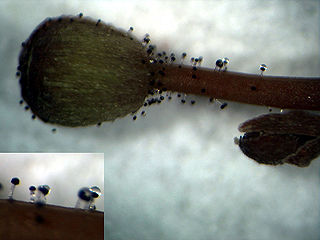The false stag beetles (Diphyllostoma) are a group of three species of rare beetles known only from California. Almost nothing is known of their life history beyond that the adults are diurnal and females are flightless; larvae have not been observed.

The gang-gang cockatoo is found in the cooler and wetter forests and woodlands of Australia, particularly alpine bushland. It is the only species placed in the genus Callocephalon. Mostly mild grey in colour with some lighter scalloping, the male has a red head and crest, while the female has a small fluffy grey crest. It ranges throughout south-eastern Australia. The gang-gang cockatoo is the faunal emblem of the Australian Capital Territory. It is easily identified by its distinctive call, which is described as resembling a creaky gate, or the sound of a cork being pulled from a wine bottle.

Acacia fimbriata, commonly known as the fringed wattle or Brisbane golden wattle, is a species of Acacia that is native along much of the east coast of Australia.

Stylidium fimbriatum is a dicotyledonous plant that belongs to the genus Stylidium. It is an erect annual plant that grows from 15 to 30 cm tall. Oblanceolate leaves, about 16 per plant, form a basal rosette around the compressed stems. The leaves are generally 5–20 mm long and 2–7 mm wide. This species generally has one or two scapes and cymose inflorescences that are 15–30 cm long. Flowers are pink with yellow highlights. S. fimbriatum's distribution is confined to the area around Bachsten Creek in the Kimberley region in Western Australia. Its typical habitat is herbfields that are seasonally wet.
Sideroxylon fimbriatum is a species of plant in the family Sapotaceae. It is endemic to Yemen. Its natural habitat is subtropical or tropical dry forests.

Allium fimbriatum is a species of wild onion known by the common name fringed onion. It is native to California and Baja California.

Allium denticulatum is a species of wild onion known by the common name toothed wild onion. It is endemic to southern California, where it grows in the western Mojave Desert, the adjacent Tehachapi Mountains, the southern Sierra Nevada, and the Palomar Mountains. It is reported from Kern, San Bernardino, Riverside, Ventura, San Diego Counties.

Geastrum fimbriatum, commonly known as the fringed earthstar or the sessile earthstar, is an inedible species of mushroom belonging to the genus Geastrum, or earthstar fungi. First described in 1829, the species has a widespread distribution, and is found in Asia, Europe, and the Americas. It is distinguished from other earthstars by the delicate fibers that line the circular pore at the top of its spore sac.

Catasetum fimbriatum, the fringed catatsetum, is a member of the orchid family of flowering plants and lives in a warm tropical environment. This plant uses a fascinating strategy to spread its pollen to other flowers via insects, primarily bees. When a pollinator lands on male flowers of C. fimbriatum and stimulates them, pollen is planted onto the back of the pollinator. This assures their gametes will be spread to other flowers the bee visits of the same species.

Dendrobium fimbriatum, commonly known as 流苏石斛 , is a species of orchid. It is native to China, the Himalayas and Indochina.
Herpetopoma fimbriatum is a species of sea snail, a marine gastropod mollusk in the family Chilodontidae.

Hakea eriantha, commonly known as tree hakea, is a shrub or small tree endemic to the east coast of Australia. It has white flowers on a woolly stem in leaf axils, long narrow leaves with reddish new growth. Found growing at higher altitudes in moist or sclerophyll Eucalyptus woodland.
Hypericum barbatum is a species of flowering plant in the family Hypericaceae. It is native to southeastern Europe, especially in Greece. The sepals bear many long silky hairs hence the specific name barbatum meaning "bearded".
Arthrostylidium fimbriatum is a species of Arthrostylidium bamboo in the grass family. The species are native to Central America, the West Indies, northern South America, and southern Mexico.
Ovulatibuccinum fimbriatum is a species of sea snail, a marine gastropod mollusc in the family Buccinidae, the true whelks.
Mallota bequaerti is a species of syrphid fly in the family Syrphidae.
Gozmanyina majestus is a species of cosmochthoniid in the family Cosmochthoniidae.
Spilomyia crandalli is a species of syrphid fly in the family Syrphidae.
Exochocepheus eremitus is a species of mite in the family Scutoverticidae.
Xenophasmina is an Asian genus of stick insects in the family Phasmatidae and subfamily Xeroderinae. Species have a known distribution from Indo-China.








